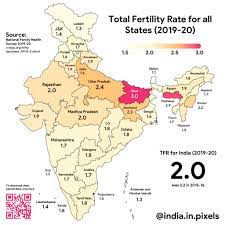Q. Why is Total Fertility rate falling in India? What are it’s implication on population explosion?
Ans: The Total Fertility Rate (TFR) is the average number of children born to a woman over her lifetime. In recent years, India has witnessed a significant decline in its TFR, which is attributed to various social, economic, and demographic factors. The falling TFR has implications for population growth and demographic transition.

Factors Contributing to Falling TFR in India:
- Urbanization and Education: As more people move to urban areas, access to education and awareness about family planning methods increase. Educated individuals tend to have fewer children as they prioritize career, personal development, and family planning.
- Economic Development: Economic growth and increased job opportunities lead to changes in lifestyle and family planning decisions. Families with better economic prospects often choose to have fewer children to ensure better quality of life for each child.
- Women’s Empowerment: Improving gender equality, access to education, and women’s participation in the workforce empower women to make informed decisions about family size and spacing of children.
- Healthcare and Family Planning Services: Improved healthcare infrastructure, access to contraceptives, and family planning services allow couples to make informed choices about childbirth and family planning.
- Social Norms and Delayed Marriages: Changing social norms, increased age at marriage, and delayed parenthood contribute to smaller family sizes as couples opt for fewer children due to the shorter reproductive span.
Implications for Population Explosion:
The declining TFR has several implications for population growth and demographic transition in India:
- Stabilizing Population Growth: A lower TFR contributes to the stabilization of population growth. As fertility rates decline, the pace of population increase slows down, reducing the potential for rapid population growth.
- Demographic Dividend: With a declining TFR, the proportion of dependent children in the population decreases relative to the working-age population. This “demographic dividend” can provide an opportunity for economic growth and development if the country invests in education, skills training, and job creation.
- Dependency Ratio: A declining TFR reduces the dependency ratio, meaning that there are fewer dependents (children and elderly) relative to the working-age population. This can potentially lead to increased savings and investment in the economy.
- Resource Allocation: A lower population growth rate allows for more efficient allocation of resources, including healthcare, education, and social services, leading to improved quality of life for the population.
- Environmental Impact: A slower population growth rate can have positive implications for environmental sustainability, as it reduces the pressure on natural resources and ecosystems.
While the declining TFR in India is a positive trend with several potential benefits, it also requires careful planning and policies to address the challenges associated with an aging population, changing family structures, and ensuring that the demographic dividend is harnessed effectively for economic development and social progress.
Thanks for reading the answer to the question: Why is Total Fertility rate falling in India? What are it’s implication on population explosion?